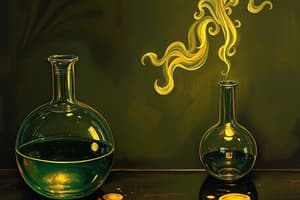Podcast
Questions and Answers
Match the following definitions with the correct terms:
Match the following definitions with the correct terms:
A pure substance consisting of one or more atoms from the same type = Element A chemical substance consisting of one molecule formed from atoms of different elements = Compound A chemical compound formed by the act of nature = Mineral A mixture of more than one mineral naturally occurring = Rock
Match the following descriptions with the correct term:
Match the following descriptions with the correct term:
Formed by artificial chemical reactions = Compound An aggregate of one or more minerals = Rock Formed by the act of nature = Mineral Consists of only one mineral type = Monomineralic rocks
Match the following examples with the correct type of rock:
Match the following examples with the correct type of rock:
Limestone (calcite) = Sedimentary rocks Quartzite (quartz) = Metamorphic rocks Claystone (clay) = Sedimentary rocks Igneous rocks = Rock
Match the following transformations with the correct rock types:
Match the following transformations with the correct rock types:
Signup and view all the answers
Match the following processes with the correct rock types:
Match the following processes with the correct rock types:
Signup and view all the answers
Match the following facts with the correct rock types:
Match the following facts with the correct rock types:
Signup and view all the answers
Match the following terms with their definitions:
Match the following terms with their definitions:
Signup and view all the answers
Match the following components found in magma with their descriptions:
Match the following components found in magma with their descriptions:
Signup and view all the answers
Match the following characteristics with the type of igneous rock they describe:
Match the following characteristics with the type of igneous rock they describe:
Signup and view all the answers
Match the processes involved in rock formation with their correct order:
Match the processes involved in rock formation with their correct order:
Signup and view all the answers
Match the factors influencing melting with their descriptions:
Match the factors influencing melting with their descriptions:
Signup and view all the answers
Match the rock types with their characteristics:
Match the rock types with their characteristics:
Signup and view all the answers




